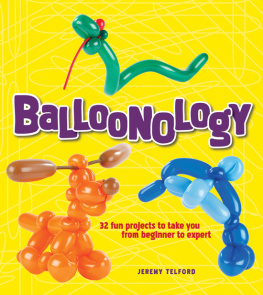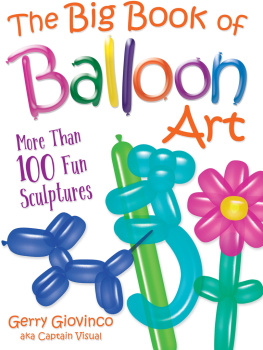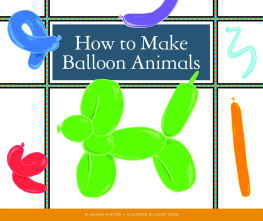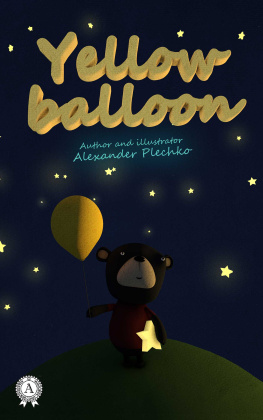Balloonology
32 Fun Projects to Take You from Beginner to Expert
Jeremy Telford
Photographs by Zac Williams

Balloonology
Digital Edition v1.0
Text 2010 Jeremy Telford
Photographs 2010 Zac Williams
All rights reserved. No part of this book may be reproduced by any means whatsoever without written permission from the publisher, except brief portions quoted for purpose of review.
Gibbs Smith, Publisher
PO Box 667
Layton, UT 84041
Orders: 1.800.835.4993
www.gibbs-smith.com
Library of Congress Catalog-in-Publishing Data
ISBN-13: 978-1-4236-0745-8
ISBN-10: 1-4236-0745-7
1. Balloon sculpture. 2. Balloon decorations I. Title.
TT926.T45 2010
745.594dc22
2010001324
For my brother-in-law Paco, who introduced me to two of my greatest loves, my wife and balloons.
Introduction
Papa, said Jack, cant you make me a balloon with this piece of whale entrail?
The Swiss Family Robinson (1813)
Balloons and balloon animals have an interesting history. The first balloons were made from animal bladders and intestines. I cant imagine they were very popular at that time, even if the entrails were cleaned really, really well. Putting my mouth on any kind of entrail is too much to ask for my art. I would rather be an accountant (sorry, Dad).
Luckily for us we now have nice, sterile, factory-made balloons to work withthey just look like intestines and bladders. It was years after this sanitary breakthrough that the first books on balloon sculpting came into being. For their time, these were innovative and creative books. They introduced to the world what balloon animals were supposed to look like. Most animals in the balloon world at the time resembled a dog with its legs stuck together. Some had longer necks and were called giraffes; others had short legs and a long tail and were called mice. Balloon animals have evolved since then. There are hundreds of beautifully rendered designs out there by as many balloon twisters. This is an art that continues to grow, mostly under the radar, but every now and then it pokes its head up and lets the public know how far it has advanced.
The books, too, have advanced. You can now find books that teach hundreds of different designs and hundreds of popular characters. They teach how to entertain and how to make money. In all there are thousands upon thousands of ways to use those little latex tubes. What we dont seem to have are books whose aim it is to teach people how to create their own designs. Im sure most have heard the Chinese proverb: Give a man a fish and you feed him for a day. Teach a man to fish and you feed him for a lifetime. What the proverb neglects to mention is how much easier it is to give that fish than to teach someone the ins and outs of fishing. This is why so many of the various how-to books choose to hand out the fish. Cookbooks rarely teach how to cook or create your own dishesthey give you step-by-step recipes to follow. Many how-to art books teach you how to draw popular characters, not how to create your own. It is so much easier to give step-by-step instructions and leave it at that. In this particular case I dont think it is done out of greed. The balloon twisting community has always been open and sharing to those who want to learn. Im sure all authors wish to sell their books, but these same people would stop and show you freely how to do a design if you ran into them on the street (unless you were in your car at the time, and even then some of them would still show you on the way to the hospital).
It is in that spirit, the spirit of sharing and...um...fishing, that this book was written. While this book contains over thirty uniquely different designs, it has much more than that. It is the purpose of this book to help you understand how, and to inspire you, to create your own designs. This is when balloon twisting really becomes fun. So you could say that this book has an infinite number of designsjust as soon as you figure them out. Thats when youll truly start fishing for yourself. (I might be overusing that fish analogy. Its starting to stink.)
If you are new to the balloon arts then I suggest you start from the beginning of the book. Learn the best way to inflate the balloon, how to tie it, and where to start twisting. When you get to the projects, it is especially important that you create them in the order they are presented in the book. Each design builds on the previous one, so creating them in order will ensure you have learned all the twists and techniques youll need to know for the next design. And be sure to make every design in the bookyoull learn a little something from each one. By the time youve finished all the designs, youll be amazed at how much you know! Then you can feel free to start playing and inventing on your own.
I placed the information you should eventually know, but that is especially boring to the beginner, at the back of the book so you dont have to read it right away. These are topics like how and where to store your balloons, the best balloon accessories, where to get a balloon apron, etc. This is stuff you should know just as soon as you feel like getting to it. I would suggest eventually getting to it.
All in all Ive tried to make this book be as informative and entertaining as any book published on the subject. Well, actually Ive tried to make it more informative and more entertaining, otherwise you might as well just buy that other book.
Now lets start twisting!
Before You Begin
Much of the following information can be found in greater detail toward the back of the book. Yet all of the following are things you need to know before you actually start twisting a sculpturethe bare bones of balloon twisting, if you will. If you have been twisting for any length of time you may already know some or all of it. If you do, please skip itI will never know that you glossed over my witty comments and insightful explanations.
The pictures in this book are here so that you can see what the twister is doing for each project. I am not holding the balloons how I would normally hold them to create the designs comfortably or quickly. Dont try to force yourself and contort your arms and hands to the pictured positionstwist however is comfortable to you and Ill give out pointers periodically on the easiest ways to hold those little latex tubes. Also, my dominant twisting hand may be different than yours. If I say right hand but it seems more comfortable in your left, then switch those directions around too.
Balloons and Popping
Your balloons will pop. They will do it more when you are first starting, but even should you become a balloon-tying grandmaster, a few will still pop. Sometimes a bag of balloons will be from a batch that didnt turn out quite right or had been left out in the sun. Maybe one or two balloons had defects. Perhaps a child or younger sibling got to your design before you finished. The point is that it will happen, even if you do everything right. Dont be surprised when it does and try not to let yourself get too frustrated.
Children and Balloons
Very, very few people are injured by balloons each year (and those are mostly due to those pesky round helium balloons). That being said, balloons can still be a choking hazard. If you suspect that a child might put the balloon in his or her mouth, then dont risk itno childs health is worth the risk. I find that by the time they are three years of age, most children have learned not to do so, but its best to just ask the parent of the child. That way you remind the parent that the balloon can be a choking hazard while at the same time finding out if the child is beyond that stage. On the other hand, you can feel good knowing that balloons themselves are relatively green. The recommended brands are made from tree sap, a renewable resource, and they are biodegradable and 100 percent nontoxic. (That still doesnt mean its okay for children to try to eat them!)











